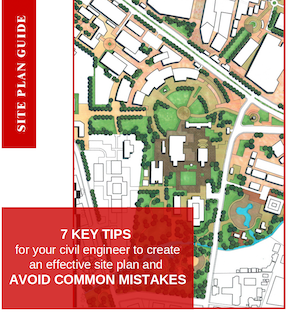Marsh & Partners Offers Rare Standalone Office Building With Future Development Potential For Sale...
The Real Estate Development Process
A Guide to Real Estate Development
Real estate development is a complicated process aimed at creating value by improving raw or vacant land or real property. The process is typically managed by a real estate developer - someone who has the industry knowledge to identify opportunities and an extensive professional network to complete a project.
Real estate developers need to be expert project managers and people connectors. A typical project will involve professionals from various industries, including attorneys, environmental consultants, architects, engineers, land planners, surveyors, lenders, and contractors - so knowing who to enlist and when to leverage their expertise is vital to the overall success of a project.
A real estate development can be a lengthy undertaking and involves varying amounts of risk depending on the type of project. Projects can range from land speculation to existing property renovation to ground-up development.
The process can be overwhelming if not properly navigated. Mistakes made during development will not only add time to a project but are often very costly. And when you've borrowed money or are responsible for managing the interests of 3rd party stakeholders, the pressure intensifies.
Planning, following a sequential process, and establishing risk mitigation measures as part of every development project are essential for success.
Traditional development projects are typically broken down into distinct phases - and from a project management perspective, those phases help delineate significant project milestones. But depending on the type and nature of a proposed project, milestones may vary, and the associated benchmarks required during each phase will change.
Below, we discuss the 4 major stages of real estate development and several important tasks implicit in each phase.
Table of Contents
Phase 1 - Site Selection & Land Acquisition
- Determine project goal and scope
- Preliminary due diligence
- Feasibility study
- Preliminary development budget and financial analysis
- Evaluate capital markets & development financing
- Purchase contract negotiation and signature
Phase 2 - Pre-development
- Site evaluation
- Assemble your real estate development team
- Site plan & construction drawings
- Land entitlement requirements
- Construction drawings review & site plan approval
- Architectural drawings and building plan review
- Pre-leasing (if necessary)
- Building permits & land entitlement
- Finalize development budget
- Finalize debt and equity financing
Phase 3 - Development & Construction
- Development & pre-construction meeting
- Preparatory site work & earthwork
- Site utilities
- Building pad & foundation
- Parking & landscaping - hard & softscape
- Building construction
- Interior buildout
- Construction management
Phase 4 - Post Construction/Closeout or Operation & Management

Phase 1 - Site Selection & Land Acquisition
A successful real estate development project begins with proper site selection. Site selection involves the process of finding a site, conducting preliminary due diligence, and determining its feasibility.
This development phase involves a substantial amount of research, analysis, and some speculation - you need to determine whether a site can accommodate your needs and whether development is viable.
The major activities involved in a proper site selection are discussed below:
Determine Project Scope and Goals
A retail build-to-suit is different from speculative multifamily development. Each completed project required a unique process, was built for a different end-user and had project-specific objectives.
Backward planning offers a project management framework to assist in the site selection process. First, you need to determine your business/financial goals and desired project end state. Then you subsequently develop an action plan. Your action plan will dictate a set of requirements that will untimely inform the site selection and land acquisition process.
If you're a small business or an operating company, a real estate strategy deep dive will be the place to start. However, before you undertake a development, it can help answer some important questions like:
- What are my 5, 10, and 20-year growth projections, and how do they impact my real estate decisions?
- What does my balance sheet say about my capital structure, and how does that impact my project?
- Given my operating margins, what kind of development arrangement makes sense?
- Does my top-line growth impact other variable business functions?
- Are my real estate and business strategies properly aligned?
- How do I best optimize my facility to support my operations?
Narrowing the project's scope and arriving at your "goal" is important. But more importantly, the intellectual process of this planning and strategy assessment will establish a solid foundation for the rest of the real estate development process.
Preliminary Real Estate Due Diligence
Before you submit an offer to purchase a property, it's important to examine the requirements involved with developing a property thoroughly. Unfortunately, most property owners won't let you conduct formal, invasive due diligence investigations until you're either under contract or have purchased an option on a site.
But public resources like tax records, geographic information system mapping, and a municipality's development guidelines can offer important insights into a property and help with your preliminary due diligence efforts.
When you're investigating a site, you'll want to be able to answer a variety of questions:
- Does the current zoning support your proposed use?
- Is the site large enough to support your proposed building?
- Are there major topographical issues that would disrupt the project or add major costs to development (streams, wetlands, elevation changes, flood zones, etc.)?
- Does the property have access to utilities on-site? Or are they near the site?
- What are (or will be) the primary avenues of ingress and egress
- If you're "forced" to close on a property, is there a viable exit plan?
- Traffic flow, visibility, and demographic statistics
It's important to note that preliminary due diligence is not exhaustive. A more comprehensive analysis will be conducted as part of the pre-development of a site. But preliminary due diligence and research will help a developer assess a site's initial risks and potential problems.
(Download our free site selection and land due diligence checklist here)
Feasibility Study
A development feasibility study is similar to a traditional business plan. It seeks to offer a roadmap for a potential project by assessing all site investigation, research, and preliminary due diligence items against potential problems and their financial implications.
The main purpose of a feasibility study is to provide a predictive analysis of the success of the overall project and the probability of various outcomes.
A feasibility study will also weigh competitor data, municipal specific requirements, demographic trends, and macroeconomic implications - developers will have much more insight into a project's potential snafus.
Preliminary Development Budget and Financial Analysis
A preliminary development budget will not be all-inclusive. Budgets conceived during the site selection phase of a project will be primarily based on historical data and educated conjecture, with some 3rd party estimates.
The budget and all associated development and project costs will then need to be rolled into a proforma to assess the financial implications.
All relevant cash flows (due diligence, acquisition, construction (both hard costs vs. soft costs), carrying costs, disposition, etc.) should be included - the financial analysis will estimate a project's yield and, ultimately, the financial return a real estate developer should expect to see.
Major roadblocks discovered during the feasibility study must be incorporated into the budget and financial analysis to properly assess the profitability of a project.
Estimating construction costs during project design and pre-development is a major challenge. It's important to work with a trusted contractor early in the design process to assist with compiling accurate cost estimates that can be used in budgeting to help make informed development decisions.
Evaluate Capital Markets & Development Financing
Financing a development project is different from applying for a residential or even a commercial mortgage. Because real estate development is inherently more speculative than an existing property acquisition, the terms and type of development financing are based on the proposed project and associated risks.
Cash, syndicated financing, crowdfunding, equity placements, joint ventures, bridge and mezzanine financing, hard money, and traditional funding - they're all viable methods of financing a development project. In addition, small-scale developers and investors can even bridge funding gaps in the project's capital stack through creative capital markets solutions - by offering opportunities to bring less sponsor capital to a project.
A developer's experience and track record and an operator's balance sheet will also be important factors when fundraising for a real estate development.
Purchase Contract Negotiation and Signature
Land contract negotiation can be a long and nuanced process. The purchase agreement needs to be comprehensive because, as a developer, you'll need to afford yourself enough time to assess the property, navigate any municipal hurdles, and fully entitle the site.

Phase 2 - Pre-development
Once you've selected a site and you have control over the property, you can begin pre-development.
The pre-development phase focuses on the key details of the project - site plan and architectural work, municipal reviews and permitting, and ultimately land entitlement.
By the end of the pre-development phase, you'll have all the approvals necessary to begin development and construction.
Site Evaluation
Site evaluation is an extension of the investigative work you did during preliminary due diligence. It involves evaluating and reporting on various physical and environmental aspects of a site that could impact a project.
There are several important evaluations to consider:
Survey
A property survey confirms a property's legal description, boundaries, and any associated easements or other restrictions included with a site.
The survey report will often include a graphic depiction of the property, including all improvements and physical features of the site. The report will help to better understand the land and inform the developer whether the site is usable for the intended purposes.
Geotechnical Survey (Soil Study)
A geotechnical engineer conducts an assessment of the ground condition, which usually involves a soil study to determine the usability of the soils on the site.
The soil study will help answer several important development questions:
- Is the site suitable for development?
- Where should you locate the building on the site?
- What soils can support well or septic installation?
- How should the building's footprint look?
Traffic Impact Analysis
A traffic impact analysis is a study that assesses how a proposed development will impact existing roadways and infrastructure.
Following the traffic impact study, recommendations and required mitigation measures will be offered. For example, depending on the size and impact of a development, it's not uncommon a project would require signalization or the dedication of right-of-way to install a turning lane.
Phase 1 Environmental Site Assessment (ESA)
A phase 1 environmental site assessment is an environmental inspection that assesses the historical and current use of a property and identifies any potential or existing environmental liabilities.
If contamination or adverse environmental conditions are identified, follow-on assessments may be required, or a project may no longer be feasible.
Off-Site Improvements
Off-site improvements are physical improvements made to roads, public right-of-ways, treatment plants, and utilities. Because of the impact a new development has on its surrounding area, many projects require work outside of a property's boundaries.
Off-site improvements can represent a major expense, and when they're unanticipated, can significantly impact the feasibility of a project.
Assemble Your Real Estate Development Team
Real estate development is a team sport. Therefore, assembling the right group of professionals and consultants, who have experience with the municipality and can navigate applicable ordinances, and have participated in similar projects is crucial to the success of a development.
The consultants are experts in navigating their specific professional fields and will largely be responsible for the development and submittal of plans and liaising with municipal authorities.
Civil Engineer
Civil engineers are experts in the planning and design of physical infrastructure based on the technical aspects of an associated piece of land.
The civil design of a site encompasses everything from topographical issues, to sidewalk and landscape design, to stormwater collection and drainage considerations. Based on a civil engineer's technical expertise and the characteristics of a site, a civil engineer will develop a site plan outlining the project's proposed layout and design.
Architect
Architects are trained in the process of planning and designing buildings. They are often involved in the construction of the buildings as well - ultimately, they're responsible for the safety and functionality of the property.
A properly designed building can help promote a company's cultural values in addition to enabling more efficient operations. Conversely, poorly designed space can substantially detract from the overall effectiveness of a building.
Land Use Attorney
A land-use attorney is an expert in all legal matters pertaining to land, zoning laws, and municipal considerations related to construction.
They can be particularly helpful when trying to rezone a property, working through recombination or subdivision cases, or when trying to navigate convoluted municipal development regulations.
General Contractor
A general contractor is responsible for the management and oversight of a construction site. In addition, they coordinate with vendors, subcontractors, and other trades to ensure the timely construction of a property.
A well-connected general contractor will have relationships with construction material suppliers and ideally has experience constructing the type of proposed development. In addition, many states require contractors to obtain certain licenses depending on the size and scope of a project.
The general contractor will also be responsible for obtaining the requisite building and construction permits required for the development.
Site Plan & Construction Drawings
The bread and butter of a real estate development is the site plan. A site plan is a geographic representation of the proposed improvements and development of a site.
A site plan should include:
- Buildings, parking lots, roads, and sidewalks
- Utilities
- Landscaping
- Property lines, setbacks, and easements
- Wetlands, floodways, and major topography
The site plan will be developed based on all municipal ordinances governing the property and any conditions discovered during due diligence and site evaluation (i.e., ground condition issues).
Engineering construction drawings also need to be developed. These documents are normally drafted and compiled by the civil engineering team and offer critical information on site development items like:
- Utility plans
- Stormwater plans
- Erosion control plans
- Site lighting plans
- Demolition plans
Construction drawings will help guide the general contractor and any subcontractor's efforts for the land development and site construction.
Land Entitlement Requirements
Land entitlement is the legal process of gaining the proper approvals for a development plan.
Because every real estate development involves a slightly different process, not every proposed project will require the approvals discussed below.
There are several common land entitlement processes to consider:
Land Rezoning
Land rezoning is the process of amending a municipalities official zoning map. Zoning ordinances control the density and types of uses allowed for individual properties - it's a method of ensuring that a community is laid out conveniently and efficiently.
The procedures for land rezoning are often prohibitive - multiple rounds of approvals, neighborhood meetings, and committee meetings are required. And the process is time-consuming, costly, and rarely certain.
So if you need to rezone land to support your proposed development, plan on an additional 6-12 months for your project, depending on the municipality.
Land Subdivision and Recombination
Each municipality has a unique definition of subdivision, but generally, it's the process of dividing a parcel of land into two or more lots for the purpose of development.
Land recombination is the process of joining two or more individual lots of land into a new configuration for the purposes of development.
Each process has its own set of regulations and approvals - and both need to be navigated before a proposed development can commence.
Utility, Road and Landscape Approvals
If a site doesn't already have utility access, you'll likely need to get utility approvals to get electric, water, and sewer extended to the property. If you're instead planning to install a well and septic tank, you'll need individual permits and approvals for each as well.
Road approvals may be required if you're developing new rights of way or need to extend an already existing road to connect with your property.
Landscape approvals may also derail or delay a development project. Various municipal ordinances cover landscaping regulations, which need to be reviewed and approved by the applicable authorities.
Zoning Variances and Conditional Use Permits
Maybe your project doesn't require a complete land rezoning. Still, you need a waiver to avoid requirements established under the zoning code - ordinances like minimum building size, height or number of stories, or setback requirements. A zoning variance would be required to deviate from those pre-established standards.
Most zoning ordinances allow for a specific set of uses, by-right. A conditional use permit allows a developer to deviate from that set of uses without having to go through the entire land rezoning process.
Engineering Construction Drawing Review and Site Plan Approval
A real estate development is simply a "proposed project" until it undergoes a rigorous municipal review and site plan approval approval process.
The site plan review will often include a zoning review and a review of design and landscape features. In addition, the plan will be reviewed for adherence to municipal ordinances governing development by a variety of government agencies, to include:
- Planning
- Environmental
- Fire and safety
- Transportation
- Public works
Once each government agency has reviewed the plan and offered corrections, and the site plan is amended to standard, the project will be issued site plan approval.
Architectural Drawings & Building Plan Review
After a site plan has been reviewed, amended, and approved, the project can move forward - construction drawings and building plans need to be submitted and approved.
The construction plans submittal and review process is not unlike the site plan review process - applicable oversight committees within the municipality need to approve the plans before construction can begin. If plans are redlined, a developer will need to amend the plans and resubmit for approval.
Pre-leasing (If Necessary)
Not all developments will require pre-leasing activities. For instance, a build-to-suit project may be pre-leased simply because a developer is constructing a custom-built property specifically for an end-user. But before a speculative development project is funded, most lenders will require a certain threshold of the project to be leased before construction begins.
In order to pre-lease space, an accurate pricing and marketing strategy is important to maximize yield per square foot while also mitigating the risk of development.
Building Permits & Land Entitlement
Once the building and construction permitting process is complete and all applicable permits have been approved for re-zoning, utilities, etc., the land is officially entitled.
Permits will be distributed, giving the developer the authority to start pushing dirt and officially begin construction.
Finalize Development Budget
The development budget should be refined and updated as the project progresses. In addition, the due diligence and entitlement process will offer a developer more insight into the cost, timing, and requirements associated with a project.
Preliminary development cost estimates should be refined, any pre-leasing activities need to be factored into potential rental income projections, and construction cost approximations should be more accurately formalized.
Even after "finalizing" the budget, a developer should be flexible. Unforeseen costs, volatile construction material input costs, and poor construction project management can all lead to budget overruns.
Finalize Debt and Equity Financing
Once land entitlement is complete, a lender will release funds to close on the property and begin developing the site. Depending on the purchase contract arrangement, a developer may close on the land after site plan approval. If that's the case, the lender would need to have a certain level of comfortability that the project will receive full permitting, at which time a lender would release funds.
If a developer has obtained financing from non-traditional sources like crowdfunding or syndication, funding may have already been issued at a different stage of the process. But it's important to note that before the land can be purchased and escrow closed, the developer will need to have a portion of the funds available.

Phase 3 - Development & Construction
The development and construction phase can begin once the land entitlement process is complete and the property sale transaction is closed.
The importance of solid construction and project management really begins in this phase of development to ensure the site is running smoothly, construction is on pace, and costs are being controlled.
Development & Pre-Construction Meeting
Before you start pushing dirt, a pre-construction meeting is important to get the team on the same page. It's a good idea to get the developer, architect, construction managers, the general contractor, and subcontractors in the same room to set expectations.
The pre-construction meeting will establish responsibilities for all involved parties, re-affirm the project's scope, and institute reporting criteria throughout the project.
Even the best-planned real estate developments don't go on without a hitch. So this meeting is essential to the success of the project.
Preparatory Sitework & Earthwork
Steps need to be taken to prepare a site before you can begin vertical construction. Preparatory site work may include:
Construction Staking
Construction staking, also known as a site layout survey, is physically marking and mapping out the land based on the approved site plan.
The staking needs to occur before a builder breaks ground on a lot and is performed to ensure that the project complies with plans and physical structures are marked at the correct elevations.
Erosion Control
Construction sites have the propensity to produce significant quantities of sediment runoff during land development. Therefore, erosion control is important to help avoid pollution and any adverse impacts on neighboring properties.
A silt fence helps with sediment control and prevents the movement of dirt and construction waste in stormwater and into bodies of water.
Land Clearing & Grading
Clearing the site of any trees, shrubs, or large rocks is an important site work process. And once the land is cleared, it needs to be graded for construction. Land grading is the process of leveling land, or at a specific slope, to lay the foundation and vertical construction.
If a site has major topographical issues, "fill dirt" can be trucked into the property to help with grading, especially if the land is not already balanced.
Stormwater
As land is developed, impervious surfaces created during construction increase runoff from rainfall. And stormwater runoff that isn't properly collected often finds itself in waterways and other bodies of water, which leads to pollution and other negative consequences.
Stormwater collection systems can take a variety of forms during a development project:
- Traditional storm drains
- Curb and gutter roadway systems
- Retention ponds
- Underground detention systems
Depending on the type of collection system, stormwater considerations can add major expenses to a development project.
Site Utilities
Since the property's utility situation was investigated during the site selection phase, the developer is already aware of the necessary utility site work. If utilities exist at the site, work will be required to connect to public utilities.
If utilities exist off-site, lines will need to be run from the development to the nearest off-site utility connection. And if the development calls for the construction of a well and septic tank, those will need to be installed.
The construction of a sewage pumping station may also be required if topography or the development doesn't facilitate the sewage to naturally flow by gravity.
Building Pad & Foundation
After the development site is staked and the land has been graded, the next step is constructing the building pad. A properly built pad aims to provide a solid surface from which to set the foundation and construct the building.
A building pad is often built in small increments and involves repeated filling and land compacting. It also extends wider than the footprint of the building to help facilitate run-off and avoid any erosion issues.
Once the building pad is set, footings are excavated, and the foundation is poured, vertical construction can begin.
Parking and Landscaping - Hard & Softscape
Once the land has been properly graded and the building pads have been built, construction can begin on the parking base and landscaping requirements.
The parking lot is paved, and any specialized horticulture work that needs to happen to the site is done. This is also when any landscape irrigation systems are installed.
The deliberate selection and presentation of trees, shrubs, and ground cover is an important aspect of a real estate development project.
Building Construction
Depending on the type of project, the physical construction of a building can take on a variety of forms. In addition, different construction techniques will require different buildout steps and can take varying lengths of time.
Generally, most construction will, at a minimum, require framing, which gives shape to the building, and of course, roofing.
Building construction is often completed to a cold dark shell condition before any interior upfit occurs.
Interior Buildout
If the property was constructed as a cold dark shell, the building would lack all of the minor details and finishing touches associated with a completed project.
The interior buildout phase is an opportunity to shape the character and aesthetic features of a development.
Buildout will often include:
- All flooring and ceiling work
- Lighting and electrical
- HVAC
- Plumbing
- Insulation and drywall
- All hardware and fixtures
In some situations, developers may choose to halt construction as shell space. This would allow potential tenants the opportunity to design and upfit the space for their unique use.
Construction Management
Construction management is the process and art of project management, but unique for construction projects. It involves the management and oversight of the planning, design, and construction phases of development.
The process of construction management needs to be employed throughout the entirety of the development and construction phase and is crucial to the timely and efficient completion of a project.
The general contractor is overall responsible for the construction of a property - but real estate developers will frequently inject themselves throughout the process as construction managers or outsource the job to a 3rd party.

Phase 4 - Post Construction/Closeout or Operation & Management
After construction, the closeout phase is the last stage during a real estate development. Every project's unique exit strategy will dictate the extent of operation and activities conducted during this phase.
Construction Closeout
Every properly managed project has a pre-determined and defined closeout process. A real estate development is no different.
A deliberate construction closeout ensures that all loose ends are tied up, paperwork and documentation are in order, and the construction and development team understands any final action items.
The development of a punch list is also important to the closeout process. A punch list is simply a comprehensive document that lists any nonconforming or outstanding action items related to construction. It allows the general contractor to rectify any issues before the final walk-through and final municipal inspections.
A general contractor is traditionally not paid in full until all punch list items are complete.
Final Construction Inspections
Once horizontal or vertical construction is completed, any interior upfit is done, and project closeout and punch list tasks are complete, it's time for final inspections and walk-through.
Typically, the developer, general contractor, and architect will do a final walk-through of the building to ensure that all items are up to code and properly installed. Common inspection items include:
- General fire & safety
- Structural and roof
- Electrical
- HVAC
- Plumbing
A local government inspector will then walk through the property to ensure the building complies with all local ordinances and regulations.
Certificate of Occupancy
A certificate of occupancy is issued when a building has passed all inspections, complies with applicable building codes, and is ready for occupancy and use.
The local municipality issues the certificate and is the final step in the construction closeout process and the final step before a new building can be legally occupied.
If the property does not pass the municipal inspection, the certificate of occupancy will not be issued, and any outstanding items need to be completed before reinspection.
Leasing & Property Stabilization
Real estate developed speculatively or as a rental investment will need to be leased after construction closeout.
Even if pre-leasing occurred, ongoing marketing and leasing activities are important to maximizing a development's financial return. At this stage of the project, the development is typically still financed through a construction loan or bridge financing. Once the percentage of occupancy reaches a specified threshold (sometimes 80-90% occupied) over a certain time period, the property is considered stabilized.
Loan Conversion
Once a property has been stabilized, a development often qualifies for more permanent financing.
Short-term bridge or construction loans can be refinanced or converted into permanent or long-term notes. Long-term financing is often issued at much lower and more competitive rates than short-term notes.
The loan conversion from short-term to long-term financing is important to the profitability of a project.
Property Management
Ongoing property management is paramount to a project's success. Depending on the types of commercial real estate leases in place, the owner and property manager will have varying levels of responsibility.
Minimizing tenant turnover, quickly filing vacancies, and effectively running the day-to-day operations are keys to long-term success.
Latest News from Marsh and Partners
Marsh & Partners Ready to Deliver New Ground-Up Build-to-Suit Industrial Building Matt Marsh,...
Marsh & Partners Publishes a Site Plan Guide Aimed At Helping Project Owners More Effectively...
Schedule a Meeting
I'm always excited to chat with folks who are interested in talking about buying and selling real estate - want to complement or diversify their operating company - or just want to brainstorm why real estate may be a smarter place to put investment dollars.
Schedule a 15-minute introductory call with me to talk about your goals and how our singular focus on problem-solving can help you achieve them.



%20copy-1.jpeg)
